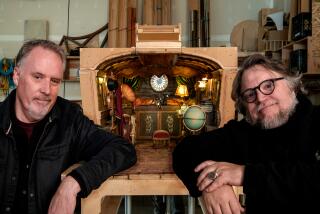Hand Him Popcorn and the Funny Glasses and He’s at His Happiest
- Share via
One day in 1947, little John Hart peered into his mother’s stereoscope and was overcome with wonder and delight at his first sight of three-dimensional pictures.
That moment was not recorded in 3-D history, but Hart has seen to it that almost everything else has been.
His fascination has never waned, and since age 7 he has collected, recorded, photographed and otherwise perpetuated every aspect of three-dimensional photography and its history.
Now Hart is a grown man in charge of the Longley Elementary School in Arcadia where the walls of his office herald the attractions of “Bwana Devil,” “House of Wax” and “Creature From the Black Lagoon.”
“This is kind of different for a principal’s office, but what the heck. It’s me,” he said.
And then he pointed out new posters that proclaim the coming of “Jaws III,” “Metalstorm” and “Space Hunter” to show that, far from being obsolete old stuff, three-dimensional movies are being produced today.
Hart, 45, appears to have been in the right place and time for his hobby all his life. He grew up in Southern California before movie audiences switched to television. His mother still owned a stereoscope, that remnant of the Victorian age when every well-appointed parlor had a box of two-picture cards and a hand-held viewer that seemed to give a magical depth to each scene.
The two pictures, taken of the same scene by camera lenses spaced about 2 1/2 inches apart, Hart said, form the basic principle of 3-D.
“I never could get enough,” he said. “I always wanted to make my own stereo cards, which I still do to some extent.”
He was 12 when the first 3-D movie, “Bwana Devil,” premiered in October, 1952, and was in his early teens when Hollywood’s short-lived profusion of 3-D movies were produced. That era ended in 1954 and the technique is only now seeing a resurgence, Hart said.
During his college years he experimented with his first synchronized twin movie cameras and projectors.
Today Hart owns about 40 theater lobby cards and posters of 3-D films, two antique stereoscopes and a big collection of old cards, numerous Polaroid glasses (made for viewing 3-D movies), and about a dozen still and movie cameras and projectors, including an intricate new camera that he said was built especially for him and is one of only three in existence.
He is a member of the Stereo (short for stereoscopic) Club of Southern California, whose 200 members make it the largest in the country, and said he has always been chairman of its 4-year-old movie division.
Hart volunteers these historical facts:
Efforts to bring depth to two-dimensional images began even before the advent of photography. Stereoscopic viewing was first recorded in the 1820s, when Charles Wheatstone rigged an apparatus with mirrors and wrote a treatise for a London society of scientists.
The Keystone-Mast Co., America’s largest producer of stereoscopes and pictures, donated its collection to the University of California, Riverside, including some invaluable pictures of Abraham Lincoln.
Hollywood promoted 3-D in an effort to draw audiences away from their first television sets. Moviegoers paid an additional 25 cents for cardboard-rimmed Polaroid glasses, which were necessary to bring the movie films’ twin images together.
“It’s hard to explain the fascination,” Hart said. “We’re fanatics. You’re either crazy about it or you couldn’t care less. There’s something very exciting about a picture of Abe Lincoln that’s so real you feel like you’re a part of it--that you could walk right into it.”
The only reason he didn’t make a career of 3-D, he said, was because “there wasn’t anything commercial out there.”
But he used it as a teaching tool when he traveled extensively and taught foreign languages, and later his special cameras and techniques recorded life with his wife, Pat, and children, Heather, 14, and Chris, 11. They live in La Crescenta.
“My whole family has grown up with 3-D. They just know you put on the glasses. Looking at flat pictures is an anomaly to them. When the neighborhood kids come in, they don’t know what’s going on,” he said.
“There’s something so magical about photography. We haven’t even started 3-D TV. And then there’s computer-generated 3-D. The possibilities just go on and on.”
More to Read
Only good movies
Get the Indie Focus newsletter, Mark Olsen's weekly guide to the world of cinema.
You may occasionally receive promotional content from the Los Angeles Times.










